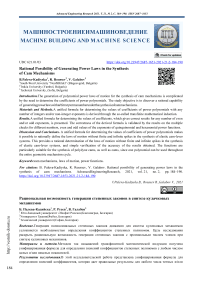Rational possibility of generating power laws in the synthesis of cam mechanisms
Автор: Paleva-kadiyska B. I., Roussev R. A., Galabov V. B.
Журнал: Вестник Донского государственного технического университета @vestnik-donstu
Рубрика: Машиностроение и машиноведение
Статья в выпуске: 2 т.21, 2021 года.
Бесплатный доступ
Introduction.The generation of polynomial power laws of motion for the synthesis of cam mechanisms is complicated by the need to determine the coefficients of power polynomials. The study objective is to discover a rational capability of generating power law swith arbitrary terms number under s with an rbitrary number of terms under the synthesis of cam mechanisms.Materials and Methods.A unified formula for determining the values of coefficients of power polynomials with any number of integers and/or non-integer exponents is derived through the so-called transfinite mathematical induction. Results.A unified formula for determining the values of coefficients, which gives correct results for any number of even and/or odd exponents, is presented. The correctness of the derived formula is validated by the results on the multiple checks for different numbers, even and odd values of the exponents of quinquinomial and hexanomial power functions. Discussion and Conclusions. A unified formula for determining the values of coefficients of power polynomials makes it possible to rationally define the laws of motion without finite and infinite spikes in the synthesis of elastic cam-lever systems. This provides a rational determination of the laws of motion without finite and infinite spikes in the synthesis of elastic cam-lever systems, and simple verification of the accuracy of the results obtained. The functions are particularly suitable for the synthesis of polydyne cams, as well as cams, since one polynomial can be used throughout the entire geometric mechanism cycle.
Cam mechanisms, laws of motion, power functions
Короткий адрес: https://sciup.org/142229422
IDR: 142229422 | DOI: 10.23947/2687-1653-2021-21-2-184-190
Список литературы Rational possibility of generating power laws in the synthesis of cam mechanisms
- Levitsky NI. Kulachkovye mekhanizmy [Cam mechanisms]. Moscow; Mashinostroenie; 1964. 287p.
- Rothbart HA. Cams. Design, Dynamics and Accuracy. NewYork: John Wiley & Sons Inc.; 1965. 336 p.
- Chen FY. Mechanics and Design of Cam Mechanisms. Pergamon Press, 1982. 523 p.
- Galabov V, Roussev R, Paleva-Kadiyska BL. Synthesis of cam mechanisms I. Sofia: New Man Publishing House; 2020. 253 p. (In Bulgarian).
- Skenderov I, Shivarov N, Galabov V. Synthesis of Pover-Polynomial Motion Laws. Problems of technical cybernetics and robotics. Sofia:Academies of Sciences of Bulgaria.2008;59:74-81.
- Galabov V, Rousev R, Shivarov N. Planning of Movement Laws Using Trigonometric Polynomials. BAS, Theor. & Appl. Mechanics. 2010;3:3-12.
- Galabov V, Savchev S, Slavov G. Planning of Motion Laws Using Power-Trigonometric Polynomials. Conferences & Symposia IFAC-PapersOnLine. 2015;48-24:134-137.
- Erdman AG, Sandor GN. Mechanism Design: Analysis and Synthesis. New Jersey: Prentice-Hall Inc.;1984. Vol. 1. 2nd ed., 1991.
- Norton RL. Design of Machinery. New York: McGraw-Hill Inc.; 1992. 306 p.
- Erdman AG(ed). Modern Kinematics. New York: John-Wiley & Sons, Inc.; 1993. 604 p.
- Uicker JJ, Pennock GR, Shigley JE. Theory of Machines and Mechanisms. 3rd ed. Oxford University Press, 2003. 768 p.
- Dudley WM. New Methods in Valve Cam Design. SAE Transactions. 1948;2(1):19-33.
- Thoren TR, Engemann HH, Stoddart DA. Cam Design as Related to Valve Train Dynamics. SAETransactions, 1952, vol. 6. https://doi.org/10.4271/520208/
- Stoddart DA. Polydyne Cam Design. Machine Design.1953;25:121-149.
- Berzak N, Freudenstein F. Optimization Criteria in Polydyne Cam Design. In: Proc. Fifth World Congress on TMM, Canada, Toronto, 1979. P. 1303-1306.
- Cardona A, Lens E, Nigro N. Optimal Design of Cams. Multibody System Dynamics. 2002;7:285-305/ https://doi.org/10.1023/A:1015278213069/ g
- Moreno D, Mucchi E, Dalpiaz G, et al. Multibody analysis of the desmodromic valve train of the Ducati g MotoGP engines. In: Proc. Multibody Dynamics 2007, ECCOMAS Thematic Conference, Italy, Milano, 2007. «
- Tounsi M, Chaari F, Walha L, et al. Dynamic behavior of a valve train system in presence of camshaft E errors. WSEAS Transactions on Theoretical Mechanics. 2011;6(1):17-26. p
- Korchemny LV. Dinamika gazoraspredelitel'nogo mekhanizma i profilirovanie kulachkov bystrokhodnykh g dvigatelei [Dynamics of the gas distribution mechanism and the profiling of the cams of high-speed engines]. Moscow: K Trudy NAMI. 1960;91;100.(In Russ.) §
- Sadek KSH, Daadbin A. Improved Cam Profiles for High-Speed Machinery Using Polynomial Curve Fitting. J. of Process Mechanical Engineering. Part E.1990; 204(2):127-132.
- Blechsmidt JL, Lee CH. Design and Analysis of Cam Profiles Using Algebraic Functions.New o York:ASME, DE.1991;32(2):451-459. H
- NortonRL. Design of Machinery. New York, McGraw-Hill Inc.;1992. 306 p. |


